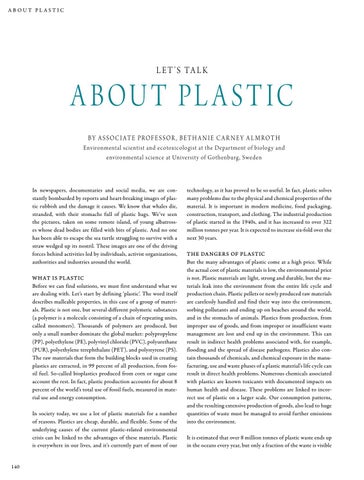ABOUT PLASTIC
L E T ’ S TA L K
A BOU T PL A ST IC B Y A S S O C I AT E P RO F E S S O R , B E T H A N I E C A R N E Y A L M RO T H Environmental scientist and ecotox icologist at the Department of biolog y and environmental science at University of Gothenburg , Sweden
In newspapers, documentaries and social media, we are constantly bombarded by reports and heart-breaking images of plastic rubbish and the damage it causes. We know that whales die, stranded, with their stomachs full of plastic bags. We’ve seen the pictures, taken on some remote island, of young albatrosses whose dead bodies are filled with bits of plastic. And no one has been able to escape the sea turtle struggling to survive with a straw wedged up its nostril. These images are one of the driving forces behind activities led by individuals, activist organizations, authorities and industries around the world. W H AT IS PL ASTIC Before we can find solutions, we must first understand what we are dealing with. Let’s start by defining ‘plastic’. The word itself describes malleable properties, in this case of a group of materials. Plastic is not one, but several different polymeric substances (a polymer is a molecule consisting of a chain of repeating units, called monomers). Thousands of polymers are produced, but only a small number dominate the global market: polypropylene (PP), polyethylene (PE), polyvinyl chloride (PVC), polyurethane (PUR), polyethylene terephthalate (PET), and polystyrene (PS). The raw materials that form the building blocks used in creating plastics are extracted, in 99 percent of all production, from fossil fuel. So-called bioplastics produced from corn or sugar cane account the rest. In fact, plastic production accounts for about 8 percent of the world’s total use of fossil fuels, measured in material use and energy consumption.
In society today, we use a lot of plastic materials for a number of reasons. Plastics are cheap, durable, and flexible. Some of the underlying causes of the current plastic-related environmental crisis can be linked to the advantages of these materials. Plastic is everywhere in our lives, and it’s currently part of most of our
140
technology, as it has proved to be so useful. In fact, plastic solves many problems due to the physical and chemical properties of the material. It is important in modern medicine, food packaging, construction, transport, and clothing. The industrial production of plastic started in the 1940s, and it has increased to over 322 million tonnes per year. It is expected to increase six-fold over the next 30 years. TH E DA NGER S OF PL ASTIC But the many advantages of plastic come at a high price. While the actual cost of plastic materials is low, the environmental price is not. Plastic materials are light, strong and durable, but the materials leak into the environment from the entire life cycle and production chain. Plastic pellets or newly produced raw materials are carelessly handled and find their way into the environment, sorbing pollutants and ending up on beaches around the world, and in the stomachs of animals. Plastics from production, from improper use of goods, and from improper or insufficient waste management are lost and end up in the environment. This can result in indirect health problems associated with, for example, flooding and the spread of disease pathogens. Plastics also contain thousands of chemicals, and chemical exposure in the manufacturing, use and waste phases of a plastic material’s life cycle can result in direct health problems. Numerous chemicals associated with plastics are known toxicants with documented impacts on human health and disease. These problems are linked to incorrect use of plastic on a larger scale. Our consumption patterns, and the resulting extensive production of goods, also lead to huge quantities of waste must be managed to avoid further emissions into the environment.
It is estimated that over 8 million tonnes of plastic waste ends up in the oceans every year, but only a fraction of the waste is visible


































